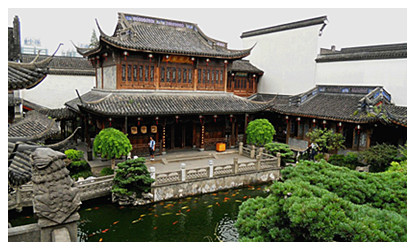
Chinese ancient architecture is one of the important parts of art appreciation. The detailed elements, colonnades, sandalwood, foundation supports and cornices extracted from Chinese ancient architectures have become the modern architectures languages. Compared to masonry structure system of western ancient architecture, Chinese ancient architecture has its own system.
1. Wood-based. Wood-based structure architecture has many advantages: the protection structure and supported structure are separated, therefore, the architecture has nice earthquake resistance, and the materials are easy to get. While it also has some disadvantages such as: easy to get fire, and suffer termite damage, so it’s keeping time is shorter than masonry structure architecture. In China, masonry structure is used in pagoda. The metal used in architecture is bronze,such as: Bowen Palace in forbidden city, Golden Temple at Wudangshan Temple, Bronze Hall of the Taihegong Taoist Temple.
2. Staging system is the main principle in wood-based structure architecture: four columns and sandal-woods consist of a room. Generally speaking, Chinese ancient architecture always has an odd number of rooms, such as three rooms, five rooms, seven rooms, nine rooms. The larger numbers of rooms the architecture has, the class of the architecture is higher, for example, the Taihe Temple in Forbidden City has eleven rooms, and it’s the existing architecture at the highest level. Actually, the shape of roof of Chinese official architecture is large, and magnificence is the most obvious characteristic of ancient Chinese architecture.
3. Dou-gong is the critical part of the timber frame. It has special external frame: many layers of stylobate, colorful curving-slope roof, courtyard type buildings. From the culture relics being unearthed from mausoleum of Han Dynasty, we can find the courtyard type buildings appear in the more than two thousand years paintings. And the magnificent Forbidden City of Ming and
Qing Dynasty adopted the complicated enclosed forms.
4.Ritual system thoughts: Chinese ancient architecture embodies Chinese ritual system thoughts. And Chinese ancient architecture stresses the hierarchical idea, pattern, scale, color, structure; all of these have strict regulations. To some extent, it developed the architectural form; meanwhile, it restricted the development of architecture. Besides, the ideology of the unity of heaven and man is also demonstrated in the development process of Chinese ancient architecture, which promotes the mutual coordination and integration of architecture and nature.
Ancient Chinese architecture is mainly timber work. Wooden posts, beams, lintels and joists make up the framework of a house. Walls serve as the separation of rooms without bearing the weight of the whole house, which is unique to
China. As a famous saying goes, 'Chinese houses will still stand when their walls collapse.' The specialty of wood requires antisepsis methods to be adopted, thus develops into Chinese own architectural painting decoration. Colored glaze roofs, windows with exquisite applique design and beautiful flower patterns on wooden pillars reflect the high-level of the craftsmen's handicraft and their rich imagination.

 Chinese ancient architecture is one of the important parts of art appreciation. The detailed elements, colonnades, sandalwood, foundation supports and cornices extracted from Chinese ancient architectures have become the modern architectures languages. Compared to masonry structure system of western ancient architecture, Chinese ancient architecture has its own system.
Chinese ancient architecture is one of the important parts of art appreciation. The detailed elements, colonnades, sandalwood, foundation supports and cornices extracted from Chinese ancient architectures have become the modern architectures languages. Compared to masonry structure system of western ancient architecture, Chinese ancient architecture has its own system. Ask Questions ?
Ask Questions ?